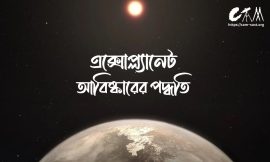We all have heard about the nucleus of an atom. If anyone is asked about the properties of a nucleus, one might answer the well-known properties such as a nucleus is so much tiny with radius of around 10-15m. It’s made of protons and neutrons and bound by a strong nuclear force.
But have you ever heard of a nucleus made entirely of neutrons? Not only that, but it is also as large as a city, with a radius of around 10-15 km (about twice the height of Mount Everest)! A star made entirely of neutrons, and so many of them exist in our observable universe. Their masses range between 1.18 and 1.97 times that of the Sun, but most are 1.35 times that of the Sun. Thus, their mean densities are extremely high, about 1014 times that of water. One teaspoon of neutron star would weigh about 10 million tons.
You may ask, How can it even be possible to create such a gigantic object only out of neutrons? What’s the mechanism of the creation? How can this type of structure even be stable? We will address these questions one by one here in this article. First, let’s see how a neutron star generally forms.
Even the brightest stars of the universe come to an end when its core runs out of fuels. Stable stars sustain nuclear fusion in their cores at high temperatures. They smash light nuclei to produce heavier ones, releasing enormous amounts of energy as a byproduct . As this fusion occurs at high temperature, this process is called ‘Thermonuclear fusion’. You may learn about ‘cold fusion’ for further study.
The massive gaseous structure of the star collapses inward due to extreme gravitational attraction.It acts like an opposite force acting opposite to the direction of fusion energy release. Thermonuclear fusion tries to expand the star towards the outer region. On the other hand, gravity tries to collapse the star into the center. In a stable star these two opposite forces are in equilibrium. This is called ‘Hydrostatic equilibrium’. As time passes by, the fuel of fusion comes to an end from time to time, breaking the equilibrium. Gravity wins over the fusion radiation and stars start to collapse. If the dying star has mass less than 1.44 times of the mass of the sun(Chandrasekhar Limit) the collapse would be countered and eventually stopped by the electron repulsion between the orbitals. This is called ‘Electron degeneracy pressure’. But if the mass is more than the Chandrasekhar limit, electron repulsion will be defied by gravitation and electrons will start to fall on the nucleus of each atom. When electrons fall on nucleus reaction, inverse beta minus decay occurs converting all the protons into neutrons.
And it follows this reaction:

These produced neutrons are fermions and obey Pauli’s exclusion principle. They don’t overlap with each other excluding the occupation of the same quantum state hence, creating ‘Neutron degeneracy pressure’. This pressure counters gravity avoiding further collapse. In this manner a star made full of neutrons is formed. Here curious people may wonder, what if the mass of a star is such that its gravity even defies the Neutron degeneracy pressure? Here comes the ‘Tolman-Oppenheimer-Volkoff’ limit, above which the star will become a ‘Black Hole’.
Back to the neutron stars, we don’t see any structure made of 2, 3 or 10 neutrons. How does this enormous structure made of millions of millions of neutrons become stable? The answer is simple: It’s gravity, where the strongest force of the universe can’t bind even 2 or 3 neutrons together to make a stable structure. Gravity itself, despite being the weakest force, binds millions to billions of neutrons together and forms a giant star. We shall calculate how many neutrons there should be to form a neutron star and will justify a formula called ‘Semi-empirical mass formula’.
A common model of nucleus is the liquid drop model. Where we assume the nucleus as a drop of liquid that can be broken into multiple drops (daughter nuclei), that has a certain homogeneous density, radius etc. If we want to calculate the binding energy of the nucleus from this model we encounter a formula,
Binding energy,

Let’s introduce the terms. Here,
av(Volume term)- implies that each nucleon is only attracted to its closest neighbors. Note that this is not true for atoms. The bigger the volume, the stronger the binding energy.
as(surface term)- Surface nucleons have fewer neighbors, so they’re less bound, just like in a water droplet. The effect is bigger in smaller nuclei because smaller nuclei have more surface relative to volume. The larger the surface, the weaker the binding energy of the nucleons near the surface of the nucleus.
ac(coulomb term)- more protons, more the coulombic repulsion, hence, decrease in binding energy
aa(Symmetry term)- nuclei prefer to have the same number of protons and neutrons, so we’re going to take the number of neutrons minus the number of protons and square it (see the formula) to deal with the problem of having too many neutrons or too many protons.ap(Pairing term)-Odd-odd nucleus has negative ap and even-even nucleus has positive ap in the formula. As even-even nucleus tends to be more stable, ap adds up into binding energy.
But still one term we are missing here. That is the gravitational binding energy in the case of neutron stars. We must add a new term. But before that we have to calculate that factor through gravitational potential .
The gravitational potential for a neutron star with radius R is V = (3GM2) / 5R. We have to add this V term into our semi-empirical mass formula. The final equation stands,

The term as can be written zero in case of a nucleus like a neutron star as volume effect is much larger than surface effect and it is not effective in large nuclei also. The coulomb term ac is also zero as there is no proton to make repulsion. Pairing term ap is zero because out of billions of neutrons one neutron making even or odd nuclei doesn’t make any difference. So, final equation stands,

A neutron star will be stable only if the binding energy is greater than zero. So, for a stable neutron star,

According to the calculations, about 1056 neutrons are needed to build a stable nucleus, not 2 or 3 or 10. With such several neutrons, gravitational force will contribute to building a neutron star, as large as the size of a city.
Can this calculation of neutron stars be an experimental evidence of a semi-empirical mass formula? Yes, of course. From the observational data, we see an average neutron star has mass more or less than the mass of our sun. Which is around 1030 kg.
Similarly, from our calculation, we got the number of neutrons to build a neutron star is around 1056. What’s the mass of 1056 neutrons?

Which is near the mass of our sun.This calculation tells us if you were to build a nucleus only out of neutrons binding them with gravitational attraction you would need neutrons of 10^29 kg! Nature can build this type of amazing objects and she has her own way of doing so i.e. Supernovas. Crushing down a star into its core and hence building this kind of marvelous structure.
Isn’t it amazing that a formula that describes the behavior of a tiny little nucleus can be verified by watching a star? The prediction of mass of a neutron star given by this formula approximately matches with the observations that we take in between interstellar distances. Hence, the equation that tells us about the structure of the unseen, that very equation can tell us about the supermassive objects.
References:
1. Britannica, The Editors of Encyclopaedia. “neutron star”. Encyclopedia Britannica, 20 May. 2023, https://www.britannica.com/science/neutron-star. Accessed 11 August 2023. Britannica, The Editors of Encyclopaedia. “neutron star”. Encyclopedia Britannica, 20 May. 2023, https://www.britannica.com/science/neutron-star. Accessed 11 August 2023.
2. Steven N. Shore,Stars, Massive,Editor(s): Robert A. Meyers,Encyclopedia of Physical Science and Technology (Third Edition),Academic Press,2003,Pages 727-736,ISBN 9780122274107, https://doi.org/10.1016/B0-12-227410-5/00725-0.(https://www.sciencedirect.com/science/article/pii/B0122274105007250)
3. Dar, J. (2014) Mass Limit of Neutron Star. International Journal of Astronomy and Astrophysics, 4, 414-418. doi: 10.4236/ijaa.2014.42036.
4. Nuclear Physics explained Course Guide book: Professor Lawrence Weinstein,Old Dominion University,pages:55-61
5.Basic ideas and Concepts of nuclear physics: AN INTRODUCTORY APPROACH,THIRD EDITION, K Heyde; Department of Subatomic and Radiation Physics,Universiteit Gent, Belgium,Chapter 7, (7.1-7b)
writer-
Roshlan Rahman Dipto
Student, Department of Nuclear Science and Engineering,
Military Institute of Science And Technology.



